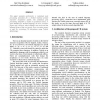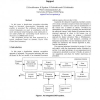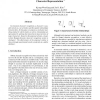ICDAR
2003
IEEE
14 years 5 months ago
2003
IEEE
It is generally agreed that an on-line recognition system is always reliable than an off-line one. It is due to the availability of the dynamic information, especially the writing...
ICDAR
2003
IEEE
14 years 5 months ago
2003
IEEE
The design of new diagram recognition systems remains a challenging problem. Ideally, recognition systems should accept real-world input, perform robustly, fail gracefully, and be...
ICDAR
2003
IEEE
14 years 5 months ago
2003
IEEE
This paper presents particularly a contextual post processing subsystem for a Turkish machine printed character recognition system. The contextual post processing subsystem is bas...
ICDAR
2003
IEEE
14 years 5 months ago
2003
IEEE
In this paper we present a top-down, projection-profile based algorithm to separate text blocks from image blocks in a Devanagari document. We use a distinctive feature of Devana...
ICDAR
2003
IEEE
14 years 5 months ago
2003
IEEE
In this communication, we propose a method for the automatic extraction of numerical fields in handwritten documents. The approach exploits the known syntactic structure of the nu...
ICDAR
2003
IEEE
14 years 5 months ago
2003
IEEE
In this paper a handwritten recognition algorithm based on structural characteristics, histograms and profiles, is presented. The well-known horizontal and vertical histograms are...
ICDAR
2003
IEEE
14 years 5 months ago
2003
IEEE
When scanning documents with a large number of pages such as books, it is often feasible to provide a minimal number of training samples to personalize the system to compensate fo...
ICDAR
2003
IEEE
14 years 5 months ago
2003
IEEE
We turn to the viewpoint of users of a DAU system. Out of the view of users we sketch a picture of “Document Analysis and Understanding” (DAU), only a simple division of DAU i...
ICDAR
2003
IEEE
14 years 5 months ago
2003
IEEE
There is a significant need to recognise the text in images on web pages, both for effective indexing and for presentation by non-visual means (e.g., audio). This paper presents a...
ICDAR
2003
IEEE
14 years 5 months ago
2003
IEEE
In structural character recognition, a character is usually viewed as a set of strokes and the spatial relationships between them. In this paper, we propose a stochastic modeling ...



